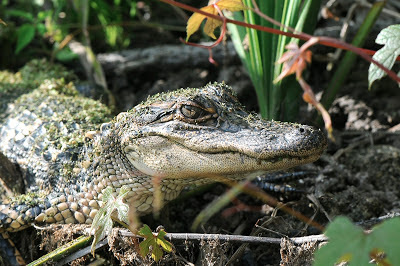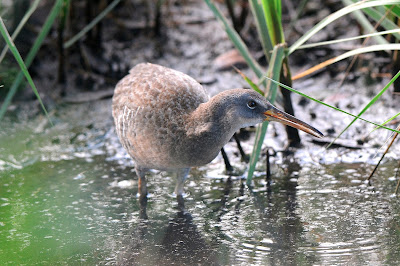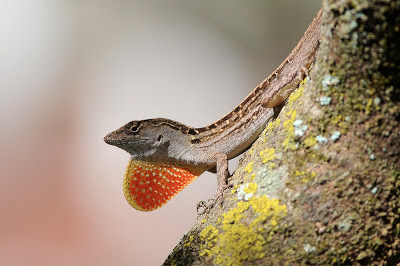I had finally made it to Georgia and was primed to start my short spring field job. First, though, was where I was to be living during my stay here. I was completely impressed with the situation; I was going to be living at the Altamaha Wildlife Management Area, just south of Darien. I didn't know it at the time but this spot is likely the best birding location in the entire county and I was going to be living there every day.
The first thing to greet me was the field house, an old historical plantation house built in the 1920s:
The house is surrounded by lush vegetation and swampy woods. Here is a view of the yard, right next to where I park my car:
If you look at that and think "Hmm, looks like there could be gators in there", you're definitely correct. Here is a small AMERICAN ALLIGATOR that was sunning itself in the yard:
There's lots of other wildlife around the house too. Here's a CAROLINA ANOLE:
Some of the common butterflies around the house include this CAROLINA SATYR:
And this HACKBERRY EMPEROR:
But as one would assume, my senses first keyed in on the local birds. I had never lived in a place quite like this. For one thing, BLACK-BELLIED WHISTLING-DUCKS are abundant around the house. I see and hear these every day, often perching actually ON the house:
Here you can see them using the observation platform across the street (no one said only humans could observe their surroundings from the platform, right?):

Every morning and evening, hundreds of WHITE IBIS fly over the house going to/from their night roost:

Arguably one of the most strikingly-colored birds here in North America is the male PAINTED BUNTING. I've been lucky to have these around all spring. In fact, as I'm typing this, the male is singing relentlessly out in the yard. Here are some photos of them from this spring:



Another family of birds well-represented behind the house here at the Altamaha WMA are the rails. There was a period where SORAS were abundant. Here's one with good light:

I was rather keen to see and photograph a KING RAIL though; I had actually never seen this species before (despite hearing it several times). The local rails provided for me. At times, their relentless "kacking" in the yard actually became distracting and somewhat annoying! Anyway, here's one peeking through the reeds:
Coming from California, I was happy to lay eyes on BLACK-THROATED BLUE WARBLERS once again. They came through the area in small numbers:

Another species of warbler that came through in decent numbers were NORTHERN WATERTHRUSHES. It wouldn't be uncommon to hear these singing in the yard Here's one skulking around:

I didn't realize it but one of the better migrant warblers I had was this very distant CAPE MAY WARBLER. I only had a couple of these:
However, probably the most-uncommon migrant I had was this BLUE-WINGED WARBLER:
The first day of work was actually spent down at Bloody Marsh on Saint Simons Island trying to trap WHIMBREL. Although we didn't catch any that day, we were lucky to catch a BLACK-BELLIED PLOVER. I was still pleased, I had never handled a BBPL before!
The flock of Eastern and Western WILLETS there at the marsh was pretty impressive though:
We spent a lot of time sitting at the edge of the marsh and when you have THAT much time, things to start to come out of the woodwork for you. The local CLAPPER RAILS are the tamest I've ever seen. We got to watch every single aspect of CLRA life; mating, nest building, courting, calling, fights, chases, swimming, bathing, feeding, etc. Here's one of the superstars:
Finally, it was time to boat out to some of the barrier islands to look for shorbs. However, we couldn't even get out there without finding some cool stuff. Here is a flexible LEAST BITTERN along the Altamaha River:

But yes, we finally got out to some of the barrier islands to start looking for migrant RED KNOTS. My job in Georgia was extremely simple on paper; resight banded knots. It didn't take too long to spot a few knots, although none of these were banded:

More interesting to me were the PARASITIC JAEGERS that we would see every once in a while. I guess I hadn't expected to be around these and I found myself very out of practice:
The MARBLED GODWITS were still around in good numbers:
Terns are very well-represented here on the coast of Georgia. Here are some ROYAL and SANDWICH TERNS along with a lone BLACK SKIMMER:

I'll leave you with a typical view of RED KNOTS here on the coastal islands of Georgia:
All these pictures were from only about a week of work. I'll post a couple more times with more Georgian goodies. Maybe before long I'll actually catch up??




























